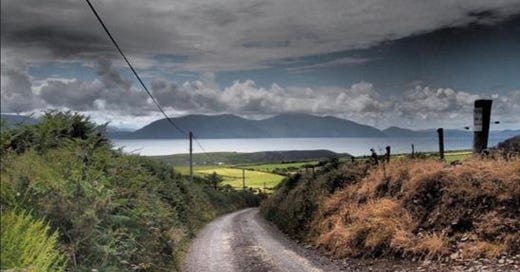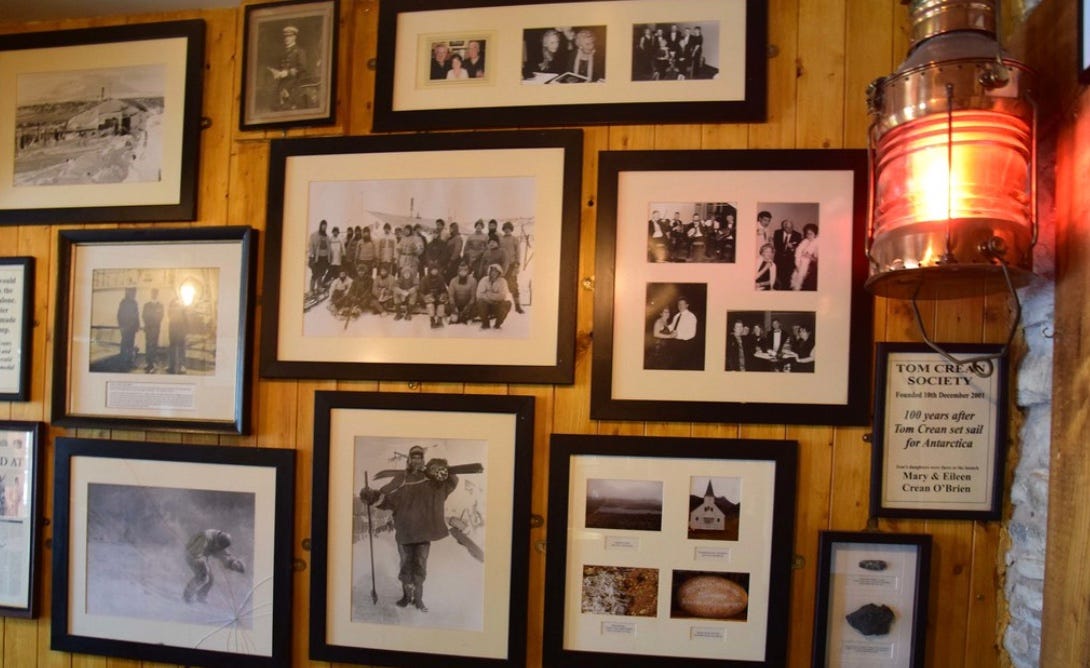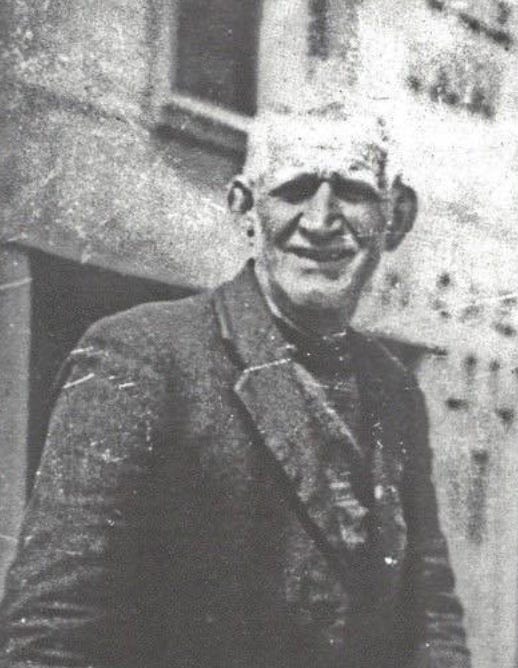I set out from Dingle town on a bike many years ago, on a day when the weather demanded you stay indoors. Every inch of rain and wind that the westerly gales and the Atlantic Ocean could throw at me, it did. It made no sense to continue, but continue I did. A kind of stubborn, youthful determination overtook me and kept me pedaling. My destination was the village of Annascaul. I chose it for no other reason than it lay at the correct distance away. I knew nothing about the place. My plan was simple: to arrive, rest, eat for an hour, and then return along the same road home.
Eventually, I arrived—exhausted and battered by the relentless wind that had blown in my face the entire way. In that state, I spotted the South Pole Inn. Like a blue beacon, it stood against the bleak gray sky at the heart of the village. Surely, I thought, it would offer something warm to soothe me. I stepped inside to find an empty bar, its wooden interior glowing from the fire crackling in the corner. The walls were adorned with black-and-white photos and memorabilia of polar exploration. It was then I learned that this was the home and bar of the legendary polar explorer Tom Crean. I had just pushed open the door feeling as close as I’d ever come to a journey that had pushed me to my limits—and here, by chance, I had stumbled upon the story of a man who had endured the unimaginable.
Tom Crean’s legacy unfolded before me that day, igniting a fascination I had never known I possessed. Born in Annascaul, Crean had been a central figure in three of the most famous Antarctic expeditions of the early 20th century, enduring extreme cold, hunger, and hardship alongside legendary explorers like Ernest Shackleton and Robert Falcon Scott. His feats of courage—trekking for miles across deadly ice to save his comrades—left me in awe. That chance encounter with Crean’s story transformed my understanding of endurance and survival, and it sparked a lifelong obsession with polar exploration. From that day forward, I devoured accounts of Arctic and Antarctic journeys, drawn to those mysterious, snow-covered landscapes at the ends of the earth. The high mountains, the frozen seas, the silence and the struggle—these became the stuff of my dreams, fueled by the memory of that windswept day in Annascaul.
I could count on one hand my memories of snow in Ireland, real snow I mean, when it lays heavy on the ground for days. Two memories stand out from my childhood, making a snowman in the garden with my brothers and, more mischiouvously, sliding down the hill by the Rye river in empty coal sacks with friends. We receive too much mist and rain and not enough snow in Ireland. But when it does arrive it still holds a magic to it. It transforms the familiar into something otherworldly. Its quietude, its cold touch, and its visual purity have a touch of the mystical. The last time it snowed heavily in Ireland I happened to be flying out that very morning to Malaga. As the Beast from the East descended over much of Europe I landed in the one place that remained settled and sunny, and I couldn’t have been more disappointed. Now, as Ireland turns the corner of another big snow event, I am in Guatemala, in very different climatic conditions, and again with a touch of sadness that I couldn’t experience Ireland in a blanket of white - for a day or two at least.
The fascination with polar exploration that began in the South Pole Inn has lingered with me ever since, intertwining itself with my fascination for polar landscapes and their transformative allure. Snow, with its stark beauty and silence, evokes a sense of the unknown, much like those vast Antarctic expanses that Crean braved.
In literature, snow is often imbued with this same duality, symbolizing both connection and isolation, beauty and desolation. James Joyce, in The Dead, captures this so profoundly in his final image of snow “falling faintly” across Ireland. His words have an unsurpassable poetic beauty to them. They resonate deeply with us. For me they echo the same emotions I feel when I think of polar landscapes.
"Yes, the newspapers were right: snow was general all over Ireland. It was falling on every part of the dark central plain, on the treeless hills, falling softly upon the Bog of Allen and, farther westward, softly falling into the dark mutinous Shannon waves. It was falling, too, upon every part of the lonely churchyard on the hill where Michael Furey lay buried. It lay thickly drifted on the crooked crosses and headstones, on the spears of the little gate, on the barren thorns. His soul swooned slowly as he heard the snow falling faintly through the universe and faintly falling, like the descent of their last end, upon all the living and the dead."
James Joyce 'The Dead'Incidentally, tomorrow, January 13th, marks the 84th year since Joyce’s death.
Another book that stayed with me was Hugh Brody’s The Other Side of Eden. He takes readers into landscapes dominated by snow, ice, and an unforgiving climate, yet brimming with life and meaning for the Indigenous peoples who have thrived there for millennia. What stood out for me most was his insights about nomadic people and the common misconceptions we have about them. Far from being aimless wanderers, as often portrayed by sedentary societies, nomadic hunter-gatherers are deeply connected to the land they traverse. Their movements are not random but intricately tied to the rhythms of nature, following cycles of animal migrations, seasonal growth, and the availability of resources. This book ignited much self-enquiry in me. And then there is the landscape he evokes. Snow, in these cultures, is not merely a backdrop but a living, shaping presence. His work invites readers to see snowy landscapes not as empty or desolate, but as vibrant and alive. I could return again and again to this book.
As I sat in the warmth of the South Pole Inn, sipping a Guinness, eating Irish stew and drying off, I found myself lingering over the story of Tom Crean. The comforts I was now enjoying were all the more pleasurable for the journey I just took. Life needs some edge and hardship to bring meaning and to feel that we are fully alive. I looked at the photos of Crean on the walls and could see that he was smiling in many of them. He was clearly loving his life. He was a man of action rather than words, enduring unimaginable hardships in the Antarctic’s frozen wilderness. Crean’s exploits are the stuff of legend: trekking 35 miles alone to save his comrades during the Terra Nova Expedition, surviving the crushing isolation of the Endurance’s icebound ordeal, and weathering the brutal storms of the open sea on Shackleton’s lifeboat journey. Yet, despite his monumental achievements, Crean’s story remained largely untold for decades.
Part of this silence was born of necessity. Returning to Ireland after a career in the Royal Navy and his polar voyages, Crean chose discretion during the turbulent years of the War of Independence. His connection to the British Navy meant it was paramount to his survival to keep his head low, running his pub in Annascaul and allowing his extraordinary past to fade into quiet obscurity. Thankfully, in recent decades his story began to be told, as best it could be, in a stage play and in the book Unsung Hero: Tom Crean—Antarctic Survivor by Michael Smith. But one can’t but wish Tom Crean was able to tell that story in his own words. I like to think it required of him an equal level of endurance, this time inwardly, to keep that story to himself, when to speak of it could have risked his life. If any man deserved to enjoy his later years it was Tom Crean.
I could have remained at the South Pole Inn all day, immersed in the photos and artifacts of exploration, but the fading light outside reminded me that I had to move. The return journey to Dingle was no less punishing than the ride out. The rain lashed harder, and the wind seemed determined to halt my progress. My legs burned with each turn of the pedals, but as I pushed through the storm, I couldn’t help but think of Crean and the miles he had endured in far harsher conditions. My belly was full from a hearty meal—the kind of feast those explorers could only dream of during their darkest hours. For them, the thought of food was a lifeline, a shared fantasy that kept their spirits alive through unimaginable suffering. Crean and his comrades had survived on little more than hard biscuits and a mug of tea, yet they pressed on through blizzards that could strip a man of hope.
As I cycled on, I felt gratitude far more than frustration. Gratitude for the warmth that waited for me at the journey’s end, for the simple luxury of a well-fed body, and for the chance to test my limits in far more forgiving conditions. By the time I returned to Dingle, drenched and aching, I carried with me not just a sense of accomplishment but a deepened respect for those who endure the unimaginable. Crean is an Irish hero if ever there was one—and an enduring reminder of the human spirit’s ability to find purpose and even joy in the struggle.









happy birthday, James Joyce. and -- beautifully written.